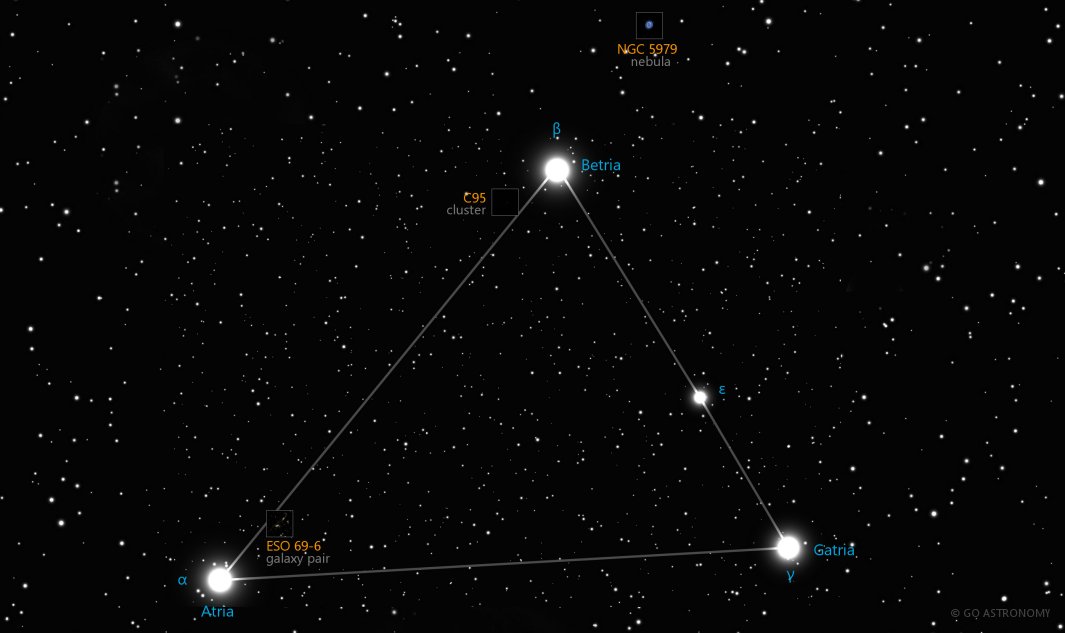Triangulum Australe, the Southern Triangle (TrA)
(try-ANG-you-lum aw-STRAL-ee)
The Southern constellation of Triangulum Australe, the Southern Triangle, is best viewed in Summer during the month of July.
Triangulum Australe is the 83rd largest constellation. It's brightest star is Atria at magnitude 1.91. The boundary of the Triangulum Australe constellation contains 1 stars that host known exoplanets.
Triangulum Australe is a circumpolar constellation, so is visible year-round in the Southern hemisphere. Conversely, it is not visible in the opposite hemisphere.
- Pronunciation:
- try-ANG-you-lum aw-STRAL-ee
- Meaning:
- Southern Triangle
- Genitive:
- Trianguli Australis
- Abbreviation:
- TrA
- Constellation Family:
- Hercules
- Hemisphere:
- Southern
- Quadrant:
- SQ3
- Visibility:
- 25° N - 90° S
- Best viewing month*:
- July
- Area:
- 110 sq. degrees
- Size:
- 83rd largest
- Circumpolar** (N=northern, S=southern):
- S circumpolar
- Right Ascension (avg):
- 16h 7m
- Declination (avg):
- -66°
- Brightest star:
- Atria (1.91)
- Stars with planets:
- 1
- X-ray stars:
- 9 (3 binaries) stars
- Messier objects:
- |
Brightest Stars in Triangulum Australe
The 10 brightest stars in the constellation Triangulum Australe by magnitude.
- Star
- Magnitude
- Spectral class
- Alpha Triangulum Australis (α TrA)
- 1.91
- K2IIb-IIIa
- Beta Triangulum Australis (β TrA)
- 2.83
- F2III
- Gamma Triangulum Australis (γ TrA)
- 2.87
- A1V
- Delta Triangulum Australis (δ TrA)
- 3.86
- G5II
- Epsilon Triangulum Australis (ε TrA)
- 4.11
- K0III
- Zeta Triangulum Australis (ζ TrA)
- 4.9
- F9V
- Triangulum Australis
- 5.1
- A0II-IIIp
- Kappa Triangulum Australis (κ TrA)
- 5.11
- G6IIa
- HD 148291
- 5.19
- K0II/IIICN
- Iota Triangulum Australis (ι TrA)
- 5.28
- F4IV
Star Clusters in Triangulum Australe
The most notable and easy-to-find star clusters in the constellation Triangulum Australe . Also see all star clusters.
Galaxies in Triangulum Australe
The most notable galaxies in the constellation Triangulum Australe. Also see all galaxies.
A Journey into the Southern Triangle
Triangulum Australe, meaning "the southern triangle" in Latin, is a small constellation in the southern celestial hemisphere. Noted for its distinct triangular shape created by three bright stars, this constellation provides an intriguing exploration into the wonders of the southern sky.
Historical Background
Triangulum Australe is not an ancient constellation. It was notably absent from Ptolemy's 2nd-century list of 48 constellations. Instead, it was fully defined and named by Dutch astronomers Pieter Dirkszoon Keyser and Frederick de Houtman in the 16th century during their explorations in the southern hemisphere. Today, it is one of the 88 modern constellations recognized by the International Astronomical Union (IAU).
Location and Principal Characteristics
Triangulum Australe is located in the third quadrant of the southern hemisphere (SQ3) and can be seen at latitudes between +25? and -90?. The constellation is bordered by Ara, Apus, Circinus, and Norma. Despite its small size, occupying an area of only 110 square degrees and ranking 83rd in size among the 88 constellations, Triangulum Australe is easily recognizable due to its clear triangular pattern.
The three brightest stars?Alpha, Beta, and Gamma Trianguli Australis?form a nearly equilateral triangle. Alpha Trianguli Australis, also known as Atria, is the brightest among them, being a giant orange star of spectral type K2IIIb that shines with an apparent magnitude of 1.91.
Celestial Bodies of Interest
Triangulum Australe does not host any Messier objects or notable galaxies, due to its small size and relative obscurity. However, it is home to several intriguing star systems and deep sky objects.
One such object is the globular cluster NGC 6025, a relatively bright cluster located approximately 2.83? west-northwest of Epsilon Trianguli Australis. This object, of apparent magnitude 7.1, can be observed with binoculars under good viewing conditions.
In addition to Atria, the constellation's other two primary stars?Beta and Gamma Trianguli Australis?are also worthy of observation. Beta is a blue-white star with a magnitude of 2.85, while Gamma is a spectroscopic binary system with a magnitude of 2.87.
Observation
For observers in the southern hemisphere, Triangulum Australe is visible in its entirety between the months of April and June. Its bright stars and clear triangular pattern make it relatively easy to spot, particularly in locations away from city light pollution. For observers in the northern hemisphere, the constellation's southern declination means that it is not visible above the horizon.
Though small and somewhat unassuming, Triangulum Australe offers a unique glimpse into the vast expanse of the southern skies. Its clear, triangular pattern, bright stars, and the interesting deep-sky object, NGC 6025, make it a constellation well worth seeking out for astronomers and star enthusiasts who find themselves under southern skies.
* Constellation shown for northen hemisphere skies. For the southern hemisphere, constellations appear rotated 180 degrees (upside-down and left-right reversed) from what is shown. Remember that seasons are reversed too - summer in northern latitudes is winter in southern latitudes.
** Circumpolar constellations are visible year-round in the hemisphere listed (and not at all in the opposite hemisphere).





